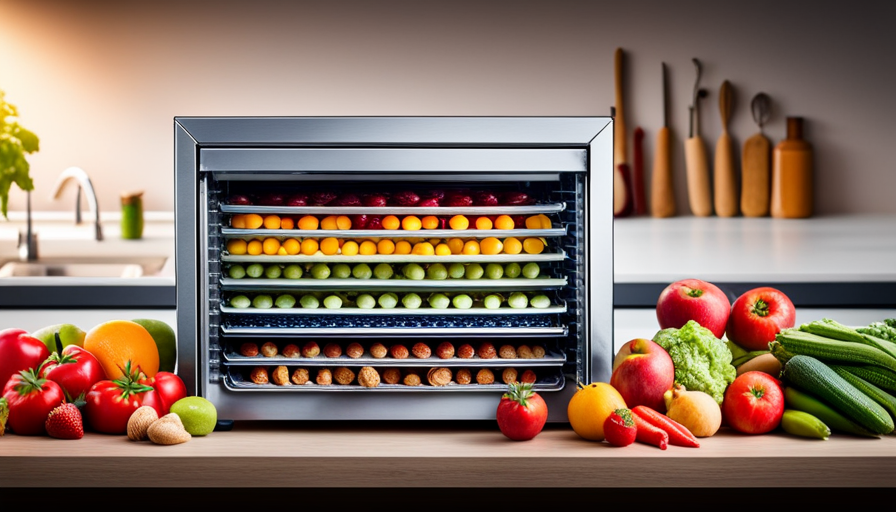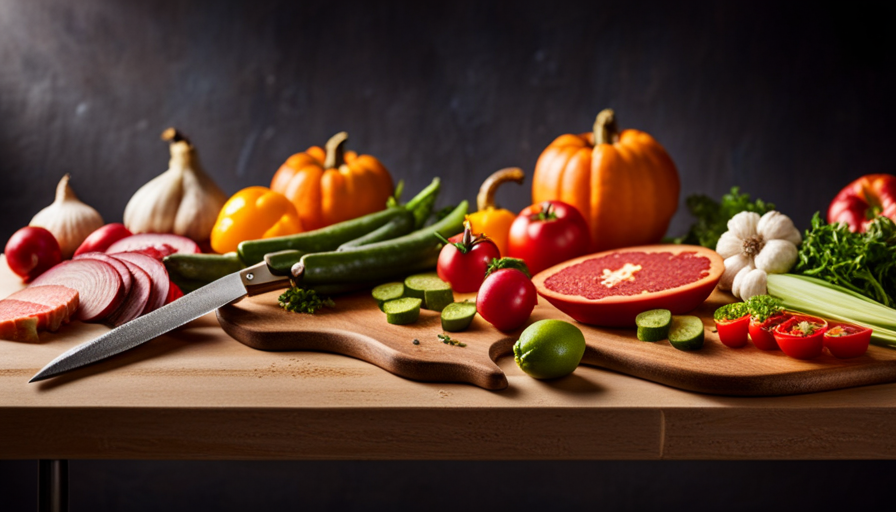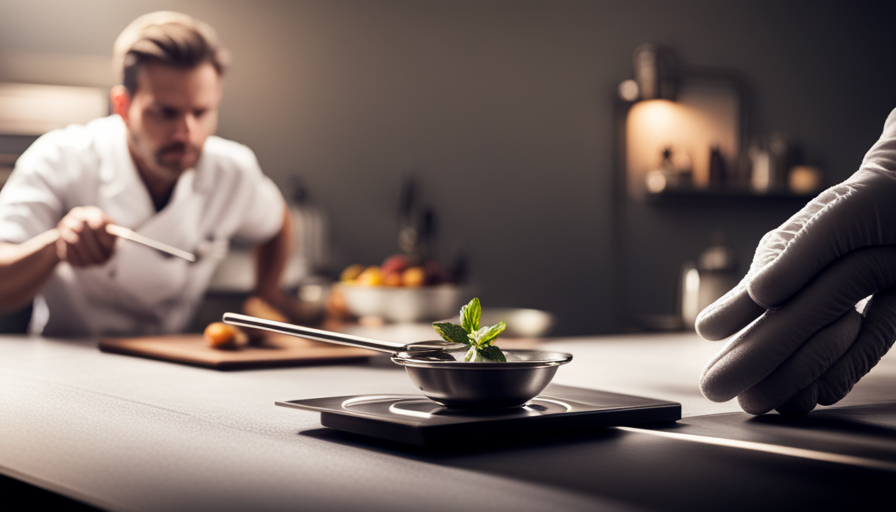So, you have decided to explore the world of raw cuisine. You have embraced the idea of nourishing your body with unprocessed ingredients that are full of nutrients.
But there’s just one problem – you’ve heard that heating raw food above 118 degrees Fahrenheit can compromise its nutritional value. Irony, isn’t it? The very act of heating becomes a challenge when you’re determined to eat raw.
Well, fear not, because in this article, we’ll explore various techniques to help you heat your raw food to that magical 118-degree mark. From using dehydrators and water baths to experimenting with sous vide techniques and low-temperature cooking methods, we’ll cover it all. We’ll even dive into creative alternatives and hot water soaking.
So, get ready to unlock the secrets of heating your raw food while maintaining its nutritional benefits. Let’s dive in!
Key Takeaways
- Raw food enthusiasts should aim to heat their food to a temperature of 118 degrees Fahrenheit or below to maintain its nutritional value.
- Heating raw food above 118 degrees compromises its nutritional value by destroying vital enzymes and nutrients.
- Temperature control techniques such as using dehydrators, low-temperature ovens, sous vide, and hot water soaking can help preserve nutrients while heating raw food to 118 degrees.
- Monitoring and adjusting the temperature throughout the cooking process is crucial to avoid overheating and ensure the preservation of nutritional benefits and flavor.
Understanding the Importance of Temperature in Raw Food
Understanding the importance of temperature in raw food is key to savoring every delicious bite. When it comes to raw food safety, maintaining the right temperature is crucial.
Raw food enthusiasts follow a temperature guideline of 118 degrees Fahrenheit or below. This is because heating above this temperature can destroy vital enzymes and nutrients that make raw food so beneficial for our health.
Enzymatic activity is essential for the digestion and absorption of nutrients in our bodies. Raw food contains natural enzymes that aid in this process. These enzymes are sensitive to temperature and can be easily destroyed when exposed to high heat. This is why it is important to keep the temperature below 118 degrees Fahrenheit when heating raw food.
To ensure that your raw food remains within the desired temperature range, there are various methods you can use. One popular method is using a dehydrator, which allows you to control the temperature precisely. Another option is using a low-temperature oven or stovetop. It’s important to monitor the temperature closely to avoid any overheating.
By understanding the importance of temperature in raw food and taking the necessary precautions, you can enjoy the benefits of raw food while ensuring its safety. So, make sure to keep that temperature below 118 degrees Fahrenheit and savor every delicious and nutritious bite.
Using a Dehydrator for Controlled Heating
To achieve the desired temperature for your uncooked meal, you can use a dehydrator, which allows you to precisely control the heating process. A dehydrator is a kitchen appliance designed to remove moisture from food. It can be a valuable tool in preparing raw food dishes that require a specific temperature of 118 degrees Fahrenheit.
One of the main advantages of using a dehydrator is its ability to provide controlled dehydration. Unlike traditional ovens or stovetops, which can easily overheat and exceed the desired temperature, a dehydrator lets you set the exact temperature you need and maintain it throughout the heating process. This ensures that your raw food is heated to the ideal temperature without going over or under.
Temperature regulation is another key feature of a dehydrator. It typically comes with adjustable temperature settings, allowing you to select the precise temperature required for your raw food recipe. This level of control is essential when trying to achieve the optimal temperature of 118 degrees for your uncooked meal.
By using a dehydrator for controlled heating, you can ensure that your raw food is heated to the desired temperature without compromising its nutritional value. The precise temperature regulation and controlled dehydration provided by a dehydrator make it an excellent choice for heating your raw food to 118 degrees Fahrenheit.
The Role of Water Baths in Gentle Heating
Water baths are a fantastic way to gently warm your dishes and maintain their delicate flavors and textures. When it comes to heating your raw food to 118 degrees, using a water bath can be an effective method.
Water baths involve immersing your food container in a larger container filled with warm water. This indirect heating method ensures that your food is heated gradually and uniformly, minimizing the risk of overcooking or losing nutrients.
To create a water bath, start by filling a larger container, such as a pot or a sink, with warm water. Make sure the water level is enough to cover your food container but not overflow. Place your food container in the water, making sure it is stable and doesn’t tip over. You can use a lid or aluminum foil to cover your food container, which helps retain heat and maintain a consistent temperature.
The slow heating process of a water bath allows your food to warm up gently, preventing any abrupt temperature changes that could alter its taste or texture. It’s important to monitor the water temperature regularly to ensure it stays around 118 degrees Fahrenheit. You can use a food thermometer to check the water temperature periodically.
Remember, water baths are not suitable for all types of foods. They work best for dishes that can tolerate gentle heating, such as sauces, custards, and certain desserts. It’s always essential to follow specific recipe instructions and adjust the water temperature accordingly.
With a water bath, you can achieve that desired gentle heat for your raw food without compromising its flavors and textures.
Exploring Sous Vide Techniques for Raw Food
Immerse your ingredients in the gentle embrace of sous vide techniques, allowing them to be cocooned in a precise and controlled environment. Sous vide, which means ‘under vacuum’ in French, is a cooking method that involves sealing food in a vacuum-sealed bag and then cooking it at a low and consistent temperature in a water bath. This technique is perfect for heating raw food to 118 degrees, as it ensures even and gentle cooking without compromising the nutritional value.
Here are four reasons why sous vide is a great option for heating raw food:
-
Precise Temperature Control: Sous vide equipment allows you to set and maintain the exact temperature you desire. This precision ensures that your raw food reaches the desired temperature of 118 degrees without overheating or undercooking.
-
Minimal Nutrient Loss: The controlled and gentle heat of sous vide helps to retain the maximum amount of nutrients in your raw food. Unlike traditional cooking methods that can lead to nutrient loss, sous vide preserves the natural flavors and nutritional value.
-
Enhanced Flavor: By cooking your raw food in a sealed bag, all the natural flavors and juices are preserved. This results in intensified flavors and a more enjoyable dining experience.
-
Consistent Results: With sous vide, you can achieve consistent results every time you cook raw food. The precise temperature control ensures that your food is cooked evenly, eliminating the risk of overcooking or uneven heating.
Incorporating sous vide techniques into your raw food preparation can be a game-changer. It allows you to heat your food to 118 degrees while retaining its nutritional value and enhancing its flavors. So go ahead and explore the world of sous vide cooking for your raw food dishes!
Utilizing Low-Temperature Cooking Methods
By utilizing low-temperature cooking techniques, you can achieve a tender and flavorful result for your culinary creations. When it comes to heating raw food to 118 degrees, there are a few options that can help you achieve the desired temperature without compromising the nutritional value of your ingredients.
One option is to use a low-temperature oven. These ovens are specifically designed to cook food at a lower temperature, typically around 200 degrees Fahrenheit or lower. They provide a gentle heat that evenly cooks your food without drying it out. Simply set the oven to the desired temperature and place your raw food inside. This method is especially useful for delicate ingredients that can easily overcook.
Another option is to utilize a slow cooker. Slow cookers are designed to cook food over a long period of time at a low temperature. They are great for heating raw food to 118 degrees because they allow for a slow and controlled cooking process. Simply place your raw food in the slow cooker, set it to the desired temperature, and let it cook for several hours. This method is perfect for tougher cuts of meat or root vegetables that benefit from a slow and steady cooking process.
Table:
| Cooking Method | Temperature Range | Benefits |
|---|---|---|
| Low-Temperature Oven | 200°F or lower | Gentle, even heat |
| Slow Cooker | Low temperature | Slow and controlled cooking |
Incorporating these low-temperature cooking methods can help you heat your raw food to 118 degrees while preserving its flavor and nutrients. Whether you choose to use a low-temperature oven or a slow cooker, these techniques will ensure that your culinary creations turn out tender and delicious.
Incorporating Warm Spices and Seasonings
If you’re looking to add some warmth and flavor to your raw food dishes while still keeping the temperature below 118 degrees, incorporating warm spices and seasonings is a fantastic way to achieve that. By using spice combinations, you can infuse your dishes with a burst of flavors that’ll leave your taste buds tingling with delight.
There are countless spice combinations you can experiment with to create unique and delicious dishes. For a slightly sweet and spicy kick, try combining cinnamon, nutmeg, and cayenne pepper. If you prefer a more savory flavor, a blend of cumin, coriander, and smoked paprika might be just what you need. Don’t be afraid to get creative and mix and match different spices to find the perfect combination for your taste preferences.
Additionally, varying the heating time for different spices can have a significant impact on the overall flavor profile of your dish. Some spices release their flavors quickly, while others take a bit longer to fully develop. By adjusting the heating time, you can control the intensity and depth of the spices in your raw food creations.
So, don’t be afraid to experiment with spice combinations and heating time variations. It’s a surefire way to elevate your raw food dishes and make them even more enjoyable and satisfying.
Creative Alternatives to Traditional Heating Methods
Get ready to think outside the box and discover some exciting and unconventional ways to add a delicious touch of warmth and flavor to your dishes without traditional heating methods.
When it comes to heating your raw food to 118 degrees, there are alternative cooking methods that can help you achieve the perfect temperature while preserving the nutrients in your food.
-
Dehydrator: Invest in a high-quality dehydrator to gently warm your raw food. This method allows for even heat distribution and helps retain the natural flavors and textures.
-
Sous Vide: Use a sous vide machine to cook your food in a temperature-controlled water bath. This method ensures precise heating without overcooking, as the food is sealed in a bag and cooked slowly at a low temperature.
-
Warm Water Bath: Place your raw food in a sealed container and submerge it in warm water for a short period. This gentle heating method will warm your food without compromising its nutritional value.
-
Warm Plate: Preheat a plate in the oven at the lowest temperature setting and then transfer your raw food onto the warm plate. This method quickly warms your dish without using direct heat.
When using alternative cooking methods, it’s important to consult raw food temperature guidelines to ensure that your food reaches the desired temperature of 118 degrees while still maintaining its raw integrity. Experiment with these creative alternatives and enjoy the warmth and flavor they bring to your raw dishes.
Experimenting with Hot Water Soaking
Now that you’ve explored some creative alternatives to traditional heating methods for your raw food, let’s dive into the exciting world of hot water soaking. This method involves immersing your food in hot water to reach the desired temperature of 118 degrees Fahrenheit.
Hot water immersion is a practical and effective way to heat your raw food while retaining its nutritional value. Simply fill a large container with water that’s heated to the desired temperature. Gently place your food into the water and let it soak for a specified amount of time, depending on the type and size of the food. This method works well for ingredients like vegetables, fruits, and nuts.
One of the key benefits of hot water soaking is its ability to effectively retain the temperature of the water. Unlike other heating methods, which can cause uneven heating or overheating, hot water soaking ensures that your food is evenly heated throughout. This gentle and precise method allows your food to reach the optimal temperature without compromising its natural enzymes and nutrients.
So, the next time you’re looking to heat your raw food to 118 degrees, consider experimenting with hot water soaking. It’s a practical and reliable method that guarantees temperature retention and preserves the goodness of your food. Get ready to enjoy delicious and nourishing meals that are perfectly heated to your liking.
Maximizing Nutritional Benefits at 118 Degrees
By utilizing the gentle and precise method of hot water soaking, you can unlock the full potential of your nourishing ingredients at the optimal temperature of 118 degrees Fahrenheit. This technique ensures that your raw food maintains its nutritional integrity while also enhancing its flavor profiles.
Hot water soaking is a practical approach to heating your food without compromising its health benefits. By immersing your ingredients in hot water, you can effectively warm them to the desired temperature while preserving their natural enzymes and nutrients. This method allows for a gradual and controlled heating process, ensuring that your food remains raw and retains its maximum nutritional value.
When heating your food to 118 degrees Fahrenheit, precision is key. It’s important to monitor the temperature closely to avoid overheating, which can lead to the loss of vital enzymes and nutrients. By using a food thermometer and maintaining a constant water temperature, you can achieve the perfect balance between heating and preserving the nutritional benefits of your raw food.
In addition to maintaining nutritional integrity, hot water soaking also maximizes flavor profiles. The gentle heat helps to release the natural flavors of the ingredients, resulting in a more vibrant and satisfying culinary experience. By cooking with precision and utilizing this method, you can ensure that your raw food isn’t just nourishing but also delicious.
Hot water soaking is an informative and practical technique for heating your raw food to 118 degrees Fahrenheit. By following the guidelines of this gentle heating method, you can maximize the nutritional benefits and flavor profiles of your nourishing ingredients. So go ahead, experiment with hot water soaking, and enjoy a wholesome and flavorful dining experience.
Tips for Maintaining Temperature Accuracy
Achieving the perfect temperature is crucial for preserving the full potential of your nourishing ingredients, ensuring they retain their maximum nutritional value and flavor. When heating your raw food to 118 degrees, it’s important to maintain temperature accuracy throughout the process. Here are some tips for maintaining temperature accuracy and control techniques to help you achieve the desired results.
-
Use a reliable thermometer: Invest in a high-quality food thermometer to accurately measure the temperature of your food. This will help you avoid undercooking or overheating your ingredients.
-
Preheat your equipment: Ensure that your dehydrator or oven is preheated to the desired temperature before placing your food inside. This will help maintain a consistent temperature throughout the cooking process.
-
Monitor and adjust: Keep a close eye on the temperature throughout the cooking process. Make adjustments as needed to maintain the desired temperature. Opening the oven or dehydrator door can cause temperature fluctuations, so try to minimize this as much as possible.
To help you visualize these temperature control techniques, here is a table summarizing the key points:
| Temperature Control Techniques |
|---|
| Use a reliable thermometer |
| Preheat your equipment |
| Monitor and adjust |
By following these tips and using proper temperature control techniques, you can ensure that your raw food is heated to 118 degrees accurately, retaining its maximum nutritional benefits and flavor.
Frequently Asked Questions
What are some alternative methods for heating raw food besides using a dehydrator or water baths?
To heat your raw food to 118 degrees without a dehydrator or water bath, there are alternative heating methods you can try. One option is using a slow cooker or crockpot on its lowest setting.
Another method is using a sous vide cooker, which allows you to precisely control the temperature. Low temperature cooking has benefits like preserving nutrients and enhancing flavors.
Experiment with these alternatives to find the method that works best for you.
Can I achieve the desired temperature of 118 degrees using sous vide techniques?
Sous vide cooking can effectively heat raw food to 118 degrees, providing precise temperature control. This method involves sealing the food in a vacuum-sealed bag and immersing it in a water bath with a sous vide machine.
The advantages of using sous vide techniques for heating raw food include even and consistent heating, which helps retain the food’s natural flavors and textures. It also reduces the risk of overcooking or undercooking, ensuring food safety and quality.
Are there any specific warm spices or seasonings that are recommended for heating raw food?
To enhance the flavor and warmth of your raw food, consider incorporating warm spices in your preparation. Spices like cinnamon, nutmeg, ginger, and cloves can add a cozy and comforting touch.
Not only do these spices impart delicious flavors, but they also offer several benefits when heating raw food to 118 degrees. Heating at this temperature can help break down enzymes and enhance digestibility, while still preserving the nutritional value of your meal.
How long should I soak my raw food in hot water to reach the desired temperature?
How long should I soak my raw food in hot water to reach the desired temperature?
It depends on the type and size of the food. As a general rule, soak smaller pieces for about 10-15 minutes, while larger pieces may require 20-30 minutes. It’s important to note that the optimal temperature for heating raw food in hot water is typically around 118 degrees Fahrenheit.
Soaking your food in hot water allows it to gradually heat up, ensuring it reaches the desired temperature without overcooking.
Is it possible to maintain a temperature of 118 degrees throughout the entire cooking process?
Maintaining a consistent temperature of 118 degrees throughout the entire cooking process can be challenging when heating raw food. Precise temperature control is crucial, as fluctuations can affect the final outcome. Factors like the cooking method, equipment used, and the food’s thickness can impact temperature consistency.
To achieve the desired temperature, consider using a thermometer to monitor and adjust heat levels as needed. Experimenting with different cooking techniques and tools can help you achieve better results.
Is Heating Raw Food to 118 Degrees Safe for Consumption?
Safely heating raw food to 118 degrees is considered safe for consumption according to the raw food diet guidelines. This temperature is believed to preserve the food’s natural enzymes and nutrients while also reducing the risk of harmful bacteria. However, it’s important to carefully monitor the temperature to ensure food safety.
Is Heating Raw Food to 118 Degrees Safe for Consumption?
Heating raw food to 118 degrees may not kill all harmful bacteria but can still be done safely. This temperature keeps food within the raw food guidelines while reducing potential health risks. It’s important to exercise caution and ensure that all necessary safety measures are in place when safely heating raw food.
Conclusion
So there you have it – a comprehensive guide on how to heat your raw food to 118 degrees! By understanding the importance of temperature in raw food and utilizing methods like dehydrators, water baths, sous vide techniques, low-temperature cooking, and hot water soaking, you can ensure that your food reaches the desired temperature while still maintaining its nutritional benefits.
Remember to always maintain temperature accuracy and experiment with creative alternatives to traditional heating methods. With these tips, you’ll be able to enjoy your raw food at the perfect temperature for maximum flavor and health benefits.
Happy cooking!










